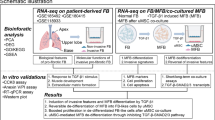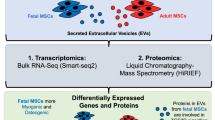Abstract
Overexposure to transforming growth factor b1 (TGF-β1) induces myofibroblastic differentiation of mesenchymal stem cells (MSCs), which could be attenuated by myeloid-derived suppressor cell (MDSC) supernatant. However, the promyofibroblastic effects of TGF-β1 and the antimyofibroblastic effects of MDSC supernatant in MSCs have not been fully elucidated. To further clarify the latent mechanism and identify underlying therapeutic targets, we used an integrative strategy combining transcriptomics and metabolomics. Bone marrow MSCs were collected 24 h following TGF-β1 and MDSC supernatant treatment for RNA sequencing and untargeted metabolomic analysis. The integrated data were then analyzed to identify significant gene-metabolite correlations. Differentially expressed genes (DEGs) and differentially expressed metabolites (DEMs) were assessed by Gene Ontology (GO) functional annotation and Kyoto Encyclopedia of Genes and Genomes (KEGG) pathway analyses for exploring the mechanisms of myofibroblastic differentiation of MSCs. The integration of transcriptomic and metabolomic data highlighted significantly coordinated changes in glycolysis/gluconeogenesis and purine metabolism following TGF-β1 and MDSC supernatant treatment. By combining transcriptomic and metabolomic analyses, this study showed that glycolysis/gluconeogenesis and purine metabolism were essential for the myofibroblastic differentiation of MSCs and may serve as promising targets for mechanistic research and clinical practice in the treatment of fibrosis by MDSC supernatant.















Similar content being viewed by others
References
Basalova N, Sagaradze G, Arbatskiy M, Evtushenko E, Kulebyakin K, Grigorieva O, Akopyan Z, Kalinina N, Efimenko A (2020) Secretome of mesenchymal stromal cells prevents myofibroblasts differentiation by transferring fibrosis-associated microRNAs within extracellular vesicles. Cells 9(5)
Cao H, Chen X, Hou J, Wang C, Xiang Z, Shen Y, Han X (2020) The Shh/Gli signaling cascade regulates myofibroblastic activation of lung-resident mesenchymal stem cells via the modulation of Wnt10a expression during pulmonary fibrogenesis. Lab Invest 100(3):363–377
Cheng J, Liu Q, Jin H, Zeng D, Liao Y, Zhao Y, Gao X, Zheng G (2021) Integrating transcriptome and metabolome variability to reveal pathogenesis of esophageal squamous cell carcinoma. Biochim Biophys Acta Mol Basis Dis 1867(1):165966
Cheuk YC, Xu S, Zhu D, Luo Y, Chen T, Chen J, Li J, Shi Y, Zhang Y, Rong R (2022) Monocytic myeloid-derived suppressor cells inhibit myofibroblastic differentiation in mesenchymal stem cells through IL-15 secretion. Frontiers in Cell and Developmental Biology 10:817402
Chinetti G, Fruchart JC, Staels B (2000) Peroxisome proliferator-activated receptors (PPARs): nuclear receptors at the crossroads between lipid metabolism and inflammation. Inflamm Res 49(10):497–505
Deng W, Wei X, Dong Z, Zhang J, Huang Z, Na N (2021) Identification of fibroblast activation-related genes in two acute kidney injury models. PeerJ 9:e10926
Ding H, Jiang L, Xu J, Bai F, Zhou Y, Yuan Q, Luo J, Zen K, Yang J (2017) Inhibiting aerobic glycolysis suppresses renal interstitial fibroblast activation and renal fibrosis. Am J Physiol Renal Physiol 313(3):F561–F575
Fan M, Zhang J, Xin H, He X, Zhang X (2018) Current perspectives on role of MSC in renal pathophysiology. Front Physiol 9:1323
Fu C, Lu Y, Williams MA, Brantly ML, Ventetuolo CE, Morel LM, Mehrad B, Scott EW, Bryant AJ (2021) Emergency myelopoiesis contributes to immune cell exhaustion and pulmonary vascular remodelling. Br J Pharmacol 178(1):187–202
Gao C, Chen J, Fan F, Long Y, Tang S, Jiang C, Wang J, Xu Y, Xu Y (2019) RIPK2-mediated autophagy and negatively regulated ROS-NLRP3 inflammasome signaling in GMCs stimulated with high glucose. Mediators Inflamm 2019:6207563
Habibie H, Adhyatmika A, Schaafsma D, Melgert BN (2021) The role of osteoprotegerin (OPG) in fibrosis: its potential as a biomarker and/or biological target for the treatment of fibrotic diseases. Pharmacol Ther 228:107941
Hochst B, Mikulec J, Baccega T, Metzger C, Welz M, Peusquens J, Tacke F, Knolle P, Kurts C, Diehl L, Ludwig-Portugall I (2015) Differential induction of Ly6G and Ly6C positive myeloid derived suppressor cells in chronic kidney and liver inflammation and fibrosis. PLoS ONE 10(3):e0119662
Ke X, Do DC, Li C, Zhao Y, Kollarik M, Fu Q, Wan M, Gao P (2019) Ras homolog family member A/Rho-associated protein kinase 1 signaling modulates lineage commitment of mesenchymal stem cells in asthmatic patients through lymphoid enhancer-binding factor 1. J Allergy Clin Immunol 143(4):1560–1574 e1566
Kim KH, Shin HJ, Kim K, Choi HM, Rhee SH, Moon HB, Kim HH, Yang US, Yu DY, Cheong J (2007) Hepatitis B virus X protein induces hepatic steatosis via transcriptional activation of SREBP1 and PPARgamma. Gastroenterology 132(5):1955–1967
Kramann R, Schneider RK, DiRocco DP, Machado F, Fleig S, Bondzie PA, Henderson JM, Ebert BL, Humphreys BD (2015) Perivascular Gli1+ progenitors are key contributors to injury-induced organ fibrosis. Cell Stem Cell 16(1):51–66
LeBleu VS, Taduri G, O’Connell J, Teng Y, Cooke VG, Woda C, Sugimoto H, Kalluri R (2013) Origin and function of myofibroblasts in kidney fibrosis. Nat Med 19(8):1047–1053
Lebrun A, Lo Re S, Chantry M, Izquierdo Carerra X, Uwambayinema F, Ricci D, Devosse R, Ibouraadaten S, Brombin L, Palmai-Pallag M, Yakoub Y, Pasparakis M, Lison D, Huaux F (2017) CCR2(+) monocytic myeloid-derived suppressor cells (M-MDSCs) inhibit collagen degradation and promote lung fibrosis by producing transforming growth factor-beta1. J Pathol 243(3):320–330
Leng D, Yi J, Xiang M, Zhao H, Zhang Y (2020) Identification of common signatures in idiopathic pulmonary fibrosis and lung cancer using gene expression modeling. BMC Cancer 20(1):986
Li J, Tu G, Zhang W, Zhang Y, Zhang X, Qiu Y, Wang J, Sun T, Zhu T, Yang C, Rong R (2021a) CHBP induces stronger immunosuppressive CD127(+) M-MDSC via erythropoietin receptor. Cell Death Dis 12(2):177
Li Y, Xu H, Cai D, Zhu S, Liu X, Zhao Y, Zhang Z, Bian Y, Xue M, Zhang L (2021b) Integration of transcriptomic, proteomic and metabolomic data to reveal the biological mechanisms of AAI injury in renal epithelial cells. Toxicol in Vitro 70:105054
Ma H, Li YN, Song L, Liu R, Li X, Shang Q, Wang Y, Shao C, Shi Y (2020) Macrophages inhibit adipogenic differentiation of adipose tissue derived mesenchymal stem/stromal cells by producing pro-inflammatory cytokines. Cell Biosci 10:88
Maione AS, Stadiotti I, Pilato CA, Perrucci GL, Saverio V, Catto V, Vettor G, Casella M, Guarino A, Polvani G, Pompilio G, Sommariva E (2021) Excess TGF-beta1 drives cardiac mesenchymal stromal cells to a pro-fibrotic commitment in arrhythmogenic cardiomyopathy. Int J Mol Sci 22(5)
Mohan V, Das A, Sagi I (2020) Emerging roles of ECM remodeling processes in cancer. Semin Cancer Biol 62:192–200
Para R, Romero F, George G, Summer R (2019) Metabolic Reprogramming as a Driver of Fibroblast Activation in PulmonaryFibrosis. Am J Med Sci 357(5):394–398
Regmi S, Pathak S, Kim JO, Yong CS, Jeong JH (2019) Mesenchymal stem cell therapy for the treatment of inflammatory diseases: challenges, opportunities, and future perspectives. Eur J Cell Biol 98(5–8):151041
Smith ER, Hewitson TD (2020) TGF-beta1 is a regulator of the pyruvate dehydrogenase complex in fibroblasts. Sci Rep 10(1):17914
Tang W, Zhang Y, Tang L, Zhang J, Xiong L, Wang B (2018) Inhibitory effect of tranilast on the myofibroblast differentiation of rat mesenchymal stem cells induced by transforming growth factorbeta1 in vitro. Mol Med Rep 18(6):5693–5700
Volarevic V, Gazdic M, Simovic Markovic B, Jovicic N, Djonov V, Arsenijevic N (2017) Mesenchymal stem cell-derived factors: Immuno-modulatory effects and therapeutic potential. BioFactors 43(5):633–644
Wang H, Leinwand LA, Anseth KS (2014) Roles of transforming growth factor-beta1 and OB-cadherin in porcine cardiac valve myofibroblast differentiation. FASEB J 28(10):4551–4562
Wang Y, Ding Y, Guo N, Wang S (2019a) MDSCs: Key criminals of tumor pre-metastatic niche formation. Front Immunol 10:172
Wang Y, Guo X, Jiao G, Luo L, Zhou L, Zhang J, Wang B (2019b) Splenectomy promotes macrophage polarization in a mouse model of concanavalin A- (ConA-) induced liver fibrosis. Biomed Res Int 2019:5756189
Xie N, Tan Z, Banerjee S, Cui H, Ge J, Liu RM, Bernard K, Thannickal VJ, Liu G (2015) Glycolytic reprogramming in myofibroblast differentiation and lung fibrosis. Am J Respir Crit Care Med 192(12):1462–1474
Yan JJ, Ryu JH, Piao H, Hwang JH, Han D, Lee SK, Jang JY, Lee J, Koo TY, Yang J (2020) Granulocyte colony-stimulating factor attenuates renal ischemia-reperfusion injury by inducing myeloid-derived suppressor cells. J Am Soc Nephrol 31(4):731–746
Zhang C, Wang S, Li J, Zhang W, Zheng L, Yang C, Zhu T, Rong R (2017) The mTOR signal regulates myeloid-derived suppressor cells differentiation and immunosuppressive function in acute kidney injury. Cell Death Dis 8(3):e2695
Zhuang Q, Ma R, Yin Y, Lan T, Yu M, Ming Y (2019) Mesenchymal stem cells in renal fibrosis: the flame of cytotherapy. Stem Cells Int 2019:8387350
Funding
This study was supported by the National Key R&D Program of China (2018YFA0107501) and National Natural Science Foundation of China (81770747 and 81970646).
Author information
Authors and Affiliations
Corresponding authors
Ethics declarations
Ethics approval
All protocols and use of laboratory animals were approved by Animal Ethics Committee of Zhongshan Hospital, Fudan University.
Conflict of interest
On behalf of all authors, the corresponding author states that there is no conflict of interest.
Additional information
Publisher's Note
Springer Nature remains neutral with regard to jurisdictional claims in published maps and institutional affiliations.
Supplementary Information
Below is the link to the electronic supplementary material.
Rights and permissions
Springer Nature or its licensor holds exclusive rights to this article under a publishing agreement with the author(s) or other rightsholder(s); author self-archiving of the accepted manuscript version of this article is solely governed by the terms of such publishing agreement and applicable law.
About this article
Cite this article
Cheuk, Y.C., Niu, X., Mao, Y. et al. Integration of transcriptomics and metabolomics reveals pathways involved in MDSC supernatant attenuation of TGF-β1-induced myofibroblastic differentiation of mesenchymal stem cells. Cell Tissue Res 390, 465–489 (2022). https://doi.org/10.1007/s00441-022-03681-2
Received:
Accepted:
Published:
Issue Date:
DOI: https://doi.org/10.1007/s00441-022-03681-2




